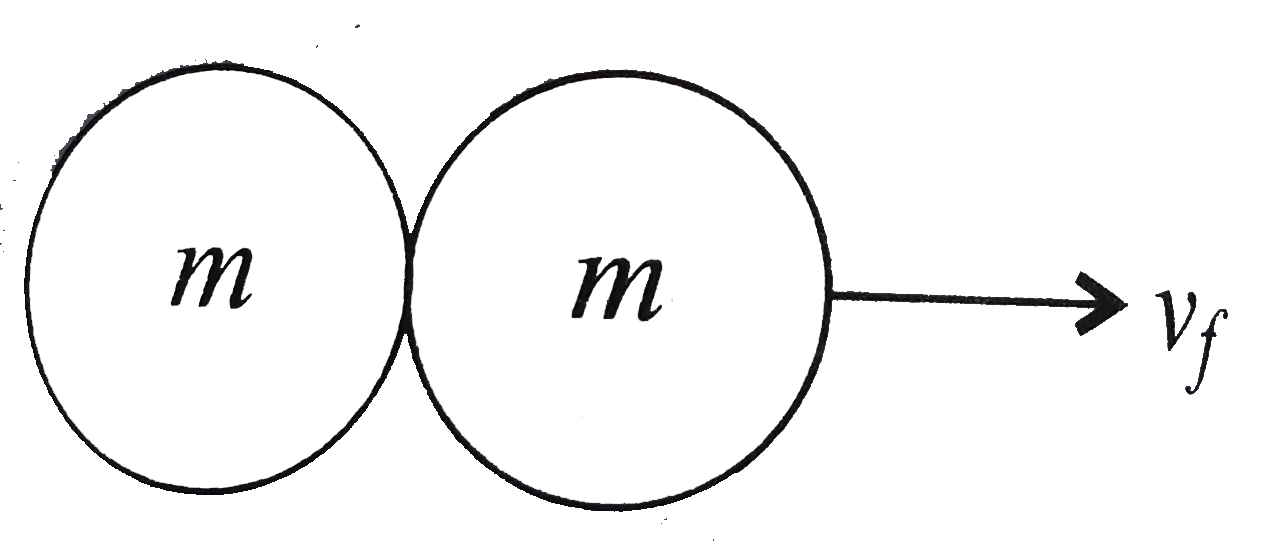In the figure , what type of collision can be possible , if K = 14 eV, 20.4 eV,22 eV, 24.18 eV,(elastic // inelastic // perfectly inelastic).

Loss in (ΔE) during the collision will be need to excite the atom of electron from one level to another. Acceleration to Bohr 's theory, for hydrogen atom.
ΔE=(0,10.2eV,12.09eV,….13.6eV)
Acceleration to Newtonion machanics, minimum loss =0 for elestic collision, For maximum loss, collision will be perfectly inelastic.

If neutron collides perfectly inelastically , then applying momentum conservation ,
mv0=2mvf⇒vr=v02
Final KE=12×2m×v204=12mv202=K2
So, maximum loss = K2
According to classical mechaincs, energy loss lies in the range :
ΔE=[0,K2]
a. K=14eV:According to quantum mechaincs,
ΔE={0,10.2eV,12.09eV}
Acceleration to classic machanics ΔE=[0.7eV]
So, possible less =0, hence it is an classic collision.
b. K=20.4eV:According to quantum mechaincs,
ΔE={0,10.2eV,12.09eV....}
Acceleration to classic machanics ΔE=[10.2eV]
If possible less =0 ⇒ classic collision ,
If less =10.2eV ⇒ inelastic collision (not perfectly),
and If loss =12.09eV⇒ perfectly inclastic collision.
Topper's Solved these Questions
- BOOK - CENGAGE PHYSICSCHAPTER - ATOMIC PHYSICSEXERCISE - Solved Examples23videos
ATOMIC PHYSICS
- BOOK - CENGAGE PHYSICSCHAPTER - ATOMIC PHYSICSEXERCISE - Exercise 4.115videos
ATOMIC PHYSICS
- BOOK - CENGAGE PHYSICSCHAPTER - ALTERNATING CURRENTEXERCISE - QUESTION BANK65videos
ALTERNATING CURRENT
- BOOK - CENGAGE PHYSICSCHAPTER - ATOMSEXERCISE - QUESTION BANK40videos
ATOMS
Similar Questions
A neutron collides with a stationary He + atom in its ground state, What should be minimum value of energy of neutron (in eV), so that all type of collisions (Elastic, inelastic and perfectly inelastic) can take place ? (Consider mass of He + atom is 4 times mass of neutron).
View SolutionA free hydrogen atom in its ground state is at rest. A neutron having kinetic energy k0 collides head one with the atom. Assume that mass of both neutron and the atom is same.
(a) Find minimum value of k0 so that this collision can be inelastic.
(b) If k0=25eV, find the kinetic energy of neutron after collision if its excites the hydrogen atom to its second excited state.
Take ionization energy of hydrogen atom in ground state to be 13.6eV.View Solution
Knowledge Check
- Question 1 - Select One
The ionisation potentials of Li and K are 5.4 and 4.3 eV respectively. The ionization potential of Na will be:
A9.7 eVB1.1 eVC4.9 eVDcannot be calculated - Question 2 - Select One
The ionisation potentials of Li and K are 5.4 and 4.3 eV respectively. The ionization potential of Na will be:
A9.7 eVB1.1 eVC4.9 eVDcannot be calculated - Question 3 - Select One
A : Work function of aluminium is 4.2 eV . Emission of electrons will be possible by two photons , each of 2.5 eV energy , striking the electron of aluminium .
R : Energy of a photon can be less then the work function of the metal , for photoelectron emission .AIf both Assertion & Reason are ture and the reason is the correct explanation of the assertion , then mark (1) .BIf both Assertion & Reason are true but the reason is not the correct explanation of the assertion , then mark (2) .CIf Assertion is true statement but Reason is false , then mark (3)DIf both Assertion and Reason are false statements , then mark (4) .
The work function of the following metal is given Na = 2.75 eV, K=2.3 eV, Mo= 4.14 eV, Ni =5.15 eV which of these metal will not give a photoelectric emission for radiation of wave length 3300A∘ from a laser source placed at 1m away from the metal . What happens if the laser is brought nearer and placed 50 cm away.
View SolutionWhich of the following statements is false for collisions-
(1)Momentum is conserved in elastic collisions but not in inelastic collisions.
(2)Total-kinetic energy is conserved in elastic collisions but momentum is not conserved.
(3)Total kinetic energy and momentum both are conserved in all types of collisions
(4)Total kinetic energy is not conserved in inelastic collisions but momentum is conservedView SolutionA particle of mass m strikes a wedge of mass M horizontally as shown in the figure.

Statement - 1 : If collision is perfectly inelastic then, it can be concluded that the particle sticks to the wedge.
Statement - 2 : In perfectly inelastic collision velocity of both bodies is same along common normal just after collision.View SolutionThe work function for the following metals is given Na: 2.75 eV, K:2.30 eV , Mo: 4.17 eV , Ni: 515 eV.
Which of these metals will not give photoelectric emission for a radiation of wavelength 3300 A from a He−Cd laser placed 1m away from the photocell? What happens if the laser is brought nearer and placed 50 cm away?View SolutionWork function of a aluminium is 4.2 eV. Emission of photoelectron is possible if two photons, each of energy 2.4 eV, are incident on an aluminium plate.
View Solution
